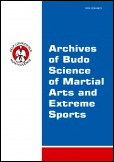2013, Volume 9, Issue 1
Three-dimensional analysis of the ju-jitsu competitors’ motion during the performance of the ippon-seoi-nage throw
Wiesław Chwała1, Tadeusz Ambroży2, Stanisław Sterkowicz3
1Department of Biomechanics, University School of Physical Education in Krakow, Krakow, Poland
2Theory and Methodology of Gymnastics Department, University School of Physical Education in Krakow, Krakow, Poland
3Theory and Methodology of Combat Sports Unit, University School of Physical Education in Krakow, Krakow, Poland
Full text
Abstract
Background and Study Aim: The seoi-nage throw is one of the most often used martial techniques in ju-jitsu and judo. The purpose of this study is the biomechanical analysis of the ippon-seoi-nage throw, based on the shifts, velocity and acceleration values of the centre of mass (CoM) of the competitor executing the technique.
Material and Methods: The technique analysis has been based on the research performed on seven Polish representatives in ju-jitsu, aged 25±1.5 years. The attacking competitors’ route of the CoM was marked, as well as the durations of motion phases. This was used to calculate the average values of the shift, velocity and acceleration values of the CoM, in a spatial coordinate system.
Results: The highest values of the CoM shifts were noted in the movement towards the opponent and to the ground. The centre of mass movement sideways with respect to the X axis is characterized by small amplitude and is clearly two-way, whereas the CoM movement downwards with respect to Z axis made up about 19% of the average height of the tested competitors. The average maximal values of the CoM resultant velocity of the competitors amounted approximately 2 m/s, whereas the acceleration amounted about 20 m/s2.
Conclusions: The ippon-seoi-nage technique is a complicated motion outline in which one must combine the elements of the progressive and rotary motion of the body. The effectiveness of the action in the attack is ensured by the fast rotation of the entire body, combined with the gained stable ground position and throwing the opponent off balance. In accordance with the defensive reaction of the opponent, the speed of fitting into the throw and the lowering of the legs are essential for the effective realization of the throw.
Key words: 3d analysis, acceleration, velocity, centre of mass, ippon-seoi-nage





